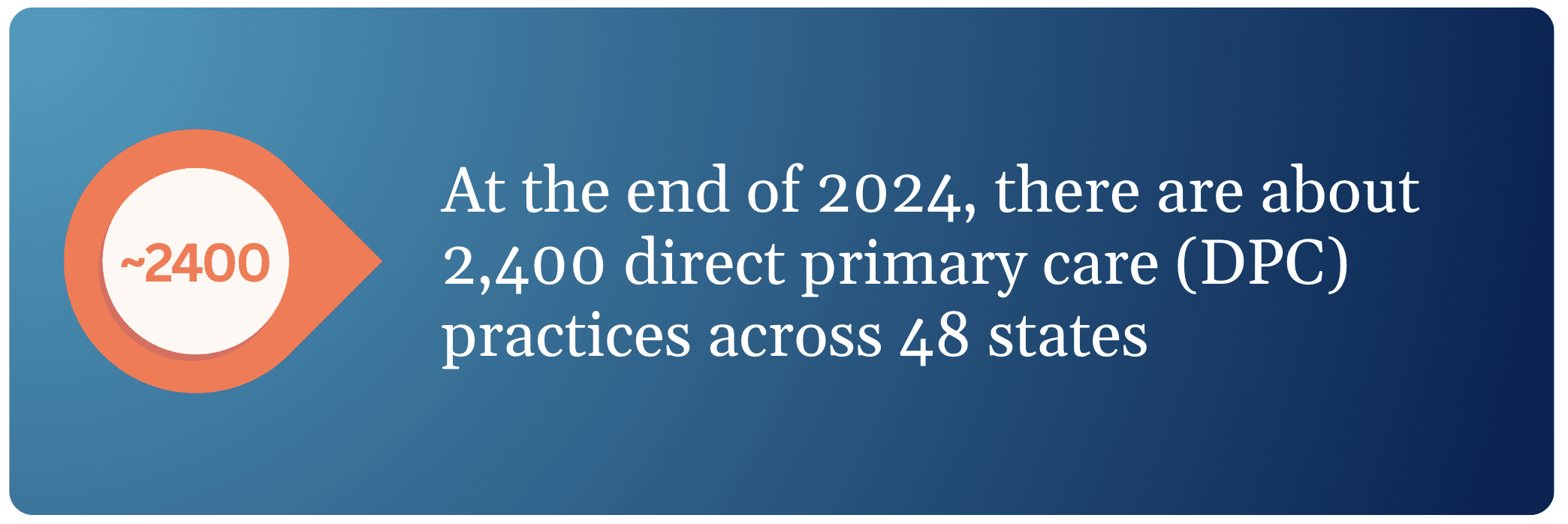Direct Primary Care Mapper: How Many DPC Practices Are in the US Today?

Although the direct primary care (DPC) model of healthcare delivery is relatively new, the number of DPC practices in the US is swiftly growing. But just how many DPC practices are there? DPC Frontier’s real-time DPC mapper gives us the answers.
If you’ve ever wondered: “How many DPC doctors are in the US today?”, the DPC mapper is perfect for you. It will help you understand the current state of direct primary care in our country.
But what is direct primary care exactly? What do DPC doctors do, and how can you become a DPC primary care physician? Let’s dive into some of the basics before taking a look at the helpful DPC mapper.
What is direct primary care, and how does it benefit patients?
Direct primary care is a membership-based care model where patients pay doctors directly with membership fees, rather than paying through an insurance provider. This gives direct primary care physicians consistent revenue and allows them to spend quality time with their patients.

A DPC membership fee covers the cost of all doctor visits and most primary care services. Patients receive better communication, longer appointments, and in some cases, even house calls.
Direct primary care physicians see benefits too. DPC can reduce administrative work associated with third-party billing and free up time for focusing on patients. DPC providers can spend more time with each patient in the office and communicate easily between visits.
AAFP describes the DPC structure as emphasizing and prioritizing the relationship between a patient and their physician to improve health outcomes and lower the overall cost of healthcare.
Now that you have a better understanding of DPC primary care, let’s take a look at the DPC mapper to see how prevalent this care model has become in the US.
DPC Mapper: How many direct primary care practices are in the US today?
The interactive and updated map on the DPC Frontier site shows that currently there are 2,060 DPC practices in the US today, spanning 48 states and Washington, DC. To qualify for inclusion on the map, the practice must meet the organization’s three-part definition of a DPC.
This means that a practice on the DPC mapper:
- Charges a periodic fee
- Does not bill any third parties on a fee-for-service basis
- Ensures that any per-visit charge is less than the monthly equivalent of the periodic fee
The organization estimates that 250,000 patients now take advantage of the DPC structure. These patients receive the benefits of primary care with no copays, greatly reduced prices on tests and medication, convenient online scheduling options, and better communication with their physicians.
Understanding the DPC mapper
The map includes three types of DPC practices:
Pure – A DPC practice that takes no insurance
Hybrid – A practice that bills insurance in addition to collecting a monthly patient membership fee
On-site – A practice that serves employees of a large corporation exclusively
The number of DPC primary care practices in the US does not include practices that are considered concierge care. These different structures are often confused and even categorized together in some instances. However, direct primary care is not the same as concierge care.
What is the difference between direct primary care and concierge care?
There are a few key differences between DPC and concierge care.
First, a DPC practice charges a flat membership fee for all services and will not bill patients separately for office visits. A concierge practice generally requires a fee for access to the practice (and for non-covered services) and may bill the patient or their insurer for office visits.
In addition, concierge practices typically charge higher fees, on average around $183 a month, compared to an average monthly fee of $77 for a DPC practice membership.
The number of patients each type of practice sees is considerably different as well. DPC practices have much smaller patient panels than traditional primary care practices (around 600 compared to 2300-2500), but a concierge practice will have even smaller patient panels.
Lastly, concierge memberships are annual, so even if you pay monthly, you can’t cancel mid-year.
As you see, there are many differences between DPC and concierge practices, so concierge practices are not included in the DPC mapper.
As more DPC providers enjoy proven success, the number of DPC practices in the US is expected to grow in the years to come.
Effective solutions for DPC doctors
If you are a direct primary care physician or are hoping to become one, you’ve come to the right place. We offer cutting-edge solutions for direct care providers.
Elation Health understands the importance of the DPC practice in today’s healthcare environment. We have created an electronic health record (EHR) solution that makes it easy for your practice to manage memberships and billing.
Our DPC all-in-one EHR helps you easily manage your DPC membership fees. And, with Direct Care EHR, you can streamline your workflow and automate your administrative processes so you can spend your time with your patients – not glued to your desk.
Elation EHR is Purpose-Built for DPC practices
If you are interested in learning more about our solutions for DPC practices, you can request a demo of Elation Health EHR or download our DPC checklist to get expert insights into everything you need to know to successfully start and run your DPC practice.
Download our free direct primary care checklist for DPC physicians
Are you considering becoming a direct primary care physician? Download our free checklist to get expert insights into how you can launch your own DPC practice.
